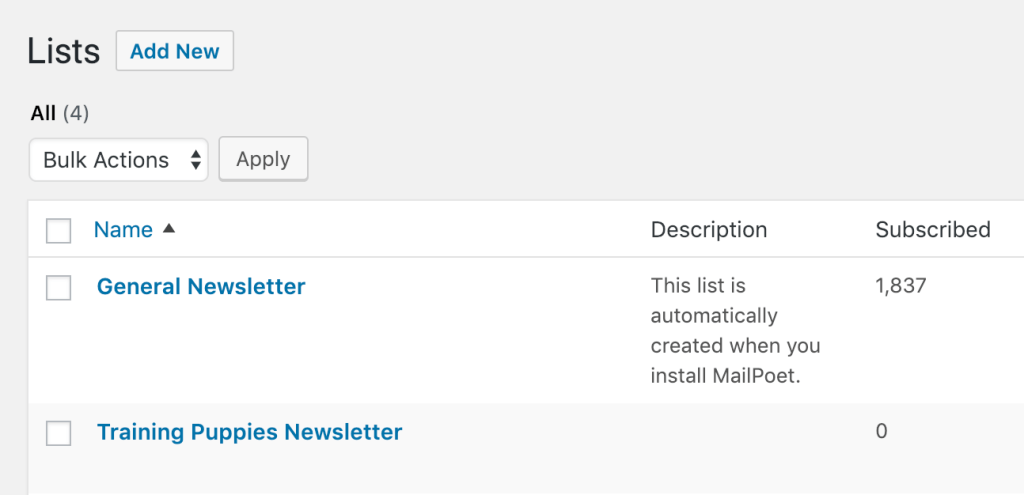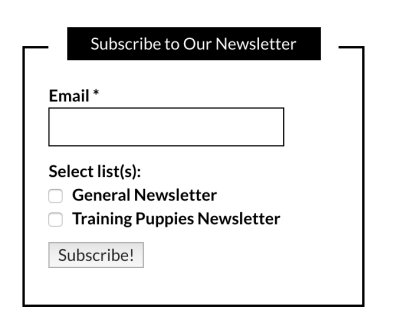When your WordPress website reaches 1,000+ subscribers, it’s time to start thinking about creating a second email newsletter if:
- Your site covers more than one topic; or
- Your website has a lot of new content.
The idea here is that you want to keep your subscribers engaged. When your subscribers are able to choose the content that interests them, they are more likely to open your emails and click-through to your links. What’s more, if you are sending a large variety of content in your newsletters, your subscribers might start feeling overwhelmed, lose interest in your emails, and become inactive.
Starting a second list is a natural way to achieve segmentation, a key part of any email marketing strategy. Consider this: research shows subscribers are 75% more likely to click on emails from segmented campaigns. In other words, email segmentation is a good step to take when you’re ready to graduate from your humble beginnings and take on true email marketing mastery!
For example, when segmenting your list, consider the categories on your website. If your website covers everything there is to know about dogs, you could create an email list for subscribers interested in learning more about health and you might have another category for training puppies.
Even if your email list boasts just 1,000 subscribers, it’s worth experimenting with a second email newsletter (a little experimentation is a good thing!) so you can compare your open and click-through rates and, ultimately, increase engagement for your website.
In this post, I’ll walk you through the following step-by-step instructions for an email segmentation experiment:
- Ask your subscribers what they think
- Create a new list, and rename your old list
- Let your new subscribers pick their list on signup
- Allow your old subscribers to change lists
- Evaluate the result of your experiment
This guide was written for MailPoet, but it can be applied for any email solution for WordPress.
1. Ask yourself (and your subscribers) if a second list is a good idea
Since this email list experiment could last for a month or two before you start seeing results, think hard about if it’s going to be worth the effort.
Starting a second mailing list means that you’ll need to spend twice as much time putting together content and sending your newsletters or emails. So be realistic since crafting an email can take quite a bit of time and, often enough, you’re working alone at it.
Simply email or directly ask your friends, family, colleagues, or subscribers who open your emails lately if they would like to receive more laser-focused content in their inbox.
You could even create a poll on Google Forms (it’s free) and link to it in your next newsletter. Your poll’s question could be:
Select the content you prefer on my website:
- All of it!
- Category A
- Category B
- Category C
If you send a lot of content, you might want to ask your subscribers if they feel they are receiving too much content.
2. Start a second newsletter for a popular topic
For this experiment, you’ll actually keep your old list and create a new one geared towards a specific content category, preferably one of the most popular categories you have on your site. You will continue sending your regular newsletter to the old list. The new list will be for a new and separate newsletter.
Let’s go back to the dog website example. It’s a great topic! One of the most popular sections with your visitors might be tips on training puppies. So it makes sense to start a new newsletter just on training puppies.
Create a new list called “Training Puppies” and make sure your original list’s name appears generalist, like “General Newsletter”:

In the next steps, you’ll see that these names are important since your subscribers will choose which list they want to subscribe to.
3. Let your new subscribers pick their lists
Next, on your subscription form, give your site visitors the option to choose which of your email lists they would like to sign up to:

With MailPoet, you can do this by adding a list selection on your forms:

4. Tell your old subscribers you have a new list
It’s a good idea to give your existing subscribers the option to sign up to your new segmented email list. The best way to do this is by announcing it in your regular newsletter:

In MailPoet, update the call-to-action button using this shortcode so it links to the correct URL:
[link:subscription_manage_url].
The above shortcode creates a unique link for each subscriber so they can manage their subscription:

Over in MailPoet’s Settings > Basics, make sure the option “Manage Subscription page” is activated:

This concludes the setup for your experiment. Pretty quick!
5. Evaluate the results of your experiment
You should start seeing results within a few weeks of sending several newsletters and visitors signing up to your new list on your website.
Simply check how many subscribers have joined your new list:

Like any list, you’ll need to work hard on making it grow, so make the most of your website’s forms!
Wrapping up
If your WordPress site has many categories of content and you regularly send email newsletters, it’s worth experimenting with a second newsletter and email list.
Make sure you ask yourself and your subscribers if you have time for this — this might be the primary factor that stops you from doing this!
If you decide to give it a try, configure your emailing solution and forms accordingly. This should be relatively quick!
After a few weeks, take a look at your lists’ statistics. Are your new and old subscribers signing up for this new list? Is it worth the effort to continue maintaining this second list?
Alternatively, you can set up an email course. In the example above, this could be a 6-week training course for puppies in which your subscribers get one lesson per week. The great thing about courses is that you only set them up once. After that, it’s all automatic and you’ll see great open rates. Fun!




Discussion